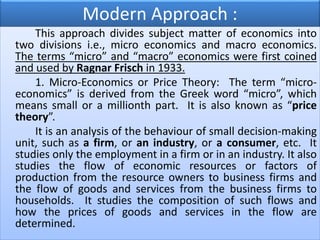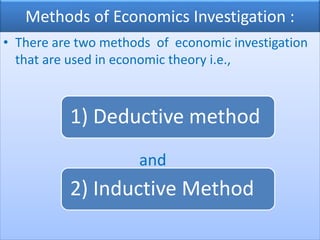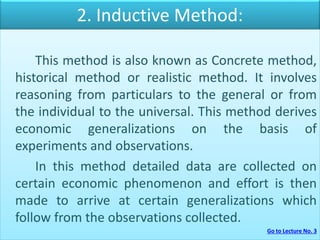Modern Approach and Methods of Economic Investigation
- 1. TOPIC-2 ŌĆó Modern Approach ŌĆó Micro-economics and Macro-economics ŌĆó Methods of Economic Investigation Deduction & Induction
- 2. Modern Approach : This approach divides subject matter of economics into two divisions i.e., micro economics and macro economics. The terms ŌĆ£microŌĆØ and ŌĆ£macroŌĆØ economics were first coined and used by Ragnar Frisch in 1933. 1. Micro-Economics or Price Theory: The term ŌĆ£micro- economicsŌĆØ is derived from the Greek word ŌĆ£microŌĆØ, which means small or a millionth part. It is also known as ŌĆ£price theoryŌĆØ. It is an analysis of the behaviour of small decision-making unit, such as a firm, or an industry, or a consumer, etc. It studies only the employment in a firm or in an industry. It also studies the flow of economic resources or factors of production from the resource owners to business firms and the flow of goods and services from the business firms to households. It studies the composition of such flows and how the prices of goods and services in the flow are determined.
- 3. Limitations of Micro-Economics: ŌĆó Micro-economic analysis suffers from certain limitations: ŌĆó It does not give an idea of the functioning of the economy as a whole. ŌĆó It fails to analyse the aggregate employment level of the economy, aggregate demand, inflation, gross domestic product, etc. ŌĆó It assumes the existence of ŌĆ£full employmentŌĆØ in the whole economy, which is practically impossible.
- 4. 2. Macro-Economics or Theory of Income and Employment: ŌĆó The term ŌĆ£macro-economicsŌĆØ is derived from the Greek word ŌĆ£macroŌĆØ, which means ŌĆ£largeŌĆØ. Macro- economics is an analysis of aggregates and averages pertaing to the entire economy, such as national income, gross domestic product, total employment, total output, total consumption, aggregate demand, aggregate supply, etc. Macro-economics looks to the nation's total economic activity to determine economic policy and promote economic progress.
- 5. Importance of Macro-Economics: ŌĆó It is helpful in understanding the functioning of a complicated economic system. ŌĆó It also studies the functioning of global economy. With growth of globalisation and WTO regime, the study of macro-economics has become more important. ŌĆó It is very important in the formulation of useful economic policies for the nation to remove the problems of unemployment, inflation, rising prices and poverty. ŌĆó Through macro-economics, the national income can be estimated and regulated. The per capita income and the peopleŌĆÖs living standard are also estimated through macro- economic study.
- 6. Limitations of Macro-Economics: ŌĆó Individual is ignored altogether. For example, in macro-economics national saving is increased through increasing tax on consumption, which directly affects the consumer welfare. ŌĆó The macro-economic analysis overlooks individual differences. For instance, the general price level may be stable, but the prices of food grains may have gone up which ruin the poor. ŌĆó A steep rise in manufactured articles may conceal a calamitous fall in agricultural prices, while the average prices were steady. The agriculturists may be ruined.
- 7. Methods of Economics Investigation : ŌĆó There are two methods of economic investigation that are used in economic theory i.e., and 1) Deductive method 2) Inductive Method
- 8. 1. Deductive Method: ŌĆó This method involves reasoning or inference from the general to the particular or from the universal to the individuals. It is also known as the abstract, analytical, hypothetical or apriori method. ŌĆó Deduction involves four steps: ŌĆó (1) Selecting the problems ŌĆó (2) Formulating the assumptions ŌĆó (3) Formulating the hypothesis through the process of logical reasoning whereby inferences are drawn and ŌĆó (4) Verifying the hypothesis.
- 9. 2. Inductive Method: This method is also known as Concrete method, historical method or realistic method. It involves reasoning from particulars to the general or from the individual to the universal. This method derives economic generalizations on the basis of experiments and observations. In this method detailed data are collected on certain economic phenomenon and effort is then made to arrive at certain generalizations which follow from the observations collected. Go to Lecture No. 3









